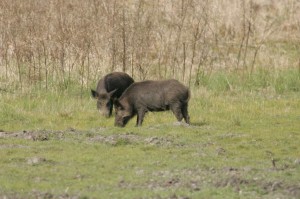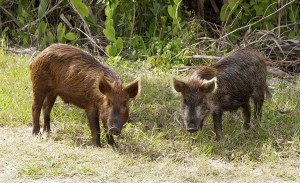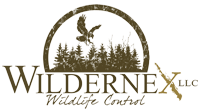 Feral hog control is a growing problem in urban and rural settings and Wildernex Wildlife Control offers hog trapping and hog control programs that can be tailor-fit to your property needs. Feral hogs are an ever-growing nuisance across North America and much of the world. Feral hogs are opportunistic omnivorous feeders that eat almost anything they come across including grass, nuts, berries, carrion, nests of ground-nesting birds, roots, tubers, refuse, insects, and small reptiles. Feral hogs vigorously root up the soil in search of these food items and are capable of destroying acres and acres of land in a single night destroying grasses, shrubs, trees, landscaping, agricultural fields, and damaging water retention and drainage areas such as levees, dams, and canals. Government statistics in 2008 indicated that feral pigs cause an estimated $800 million of property damage per year in the U.S. alone and that number continues to rise. Most states in the U.S. have declared feral hogs to be a nuisance invasive species and spend large amounts of money in efforts to control them. Feral hogs not only damage property but also kill, consume, and out-compete many native plant and animal species. Texas is home to the largest population of feral hogs in the U.S. with an estimated population in excess of 2 million out of the estimated national population of over 4 million. Despite countless efforts to control feral hogs, these population numbers continue to rise as they are capable of reproducing at rapid rates. Female hogs, known as sows, are sexually mature at 8 months of age and are capable of having two litters per year with each litter potentially containing up to 14 piglets.
Feral hog control is a growing problem in urban and rural settings and Wildernex Wildlife Control offers hog trapping and hog control programs that can be tailor-fit to your property needs. Feral hogs are an ever-growing nuisance across North America and much of the world. Feral hogs are opportunistic omnivorous feeders that eat almost anything they come across including grass, nuts, berries, carrion, nests of ground-nesting birds, roots, tubers, refuse, insects, and small reptiles. Feral hogs vigorously root up the soil in search of these food items and are capable of destroying acres and acres of land in a single night destroying grasses, shrubs, trees, landscaping, agricultural fields, and damaging water retention and drainage areas such as levees, dams, and canals. Government statistics in 2008 indicated that feral pigs cause an estimated $800 million of property damage per year in the U.S. alone and that number continues to rise. Most states in the U.S. have declared feral hogs to be a nuisance invasive species and spend large amounts of money in efforts to control them. Feral hogs not only damage property but also kill, consume, and out-compete many native plant and animal species. Texas is home to the largest population of feral hogs in the U.S. with an estimated population in excess of 2 million out of the estimated national population of over 4 million. Despite countless efforts to control feral hogs, these population numbers continue to rise as they are capable of reproducing at rapid rates. Female hogs, known as sows, are sexually mature at 8 months of age and are capable of having two litters per year with each litter potentially containing up to 14 piglets.
Feral hogs are known for their aggressive nature. Boars are typically most aggressive during mating seasons and females are aggressive when protecting their young. If threatened, feral hogs will charge full speed causing damage with the impact of their hard thick skulls. Sows typically have small tusks and therefore charge with an open mouth and bite. Boars typically have large tusks and whip their heads upward on impact causing severe lacerations. Most injuries to humans typically occur on the upper leg due to the average height of most hogs. Although most attacks are treatable, some fatalities have occurred from feral hog attacks.
Feral hogs also spread numerous diseases to humans and animals and pose a major threat to livestock. Hogs are known to carry and or transmit pseudorabies, swine brucellosis, tuberculosis, anthrax, and tularemia. Pseudorabies is a viral disease of the central nervous system and can be easily transmitted to cattle, horses, goats, sheep, dogs, and cats. Other wild animals such as raccoons, skunks, opossums, and small rodents can also be fatally infected. Pseudorabies is different from the rabies virus but is a serious threat to domestic animals and wildlife. Recognized endemic areas of anthrax cases in feral hogs include portions of Texas, Louisiana, California, Arkansas, Mississippi, Nebraska, South Dakota, and small areas in other states. Feral Hogs also harbor parasites such as hog lice, ticks, and endoparasites including worms and flukes.
Feral hog removal and feral hog control is a labor-intensive process that requires specific knowledge and experience of animal behavior. If you need feral hog removal, feral hog trapping, or long term feral hog control, Wildernex can provide these services to protect you and your property.
Have questions about wildlife control? Check out our FAQ page or contact us for your answers!
Wildernex Wildlife Control offers Feral Hog Control in Houston, Austin, Dallas Fort Worth, and San Antonio!
